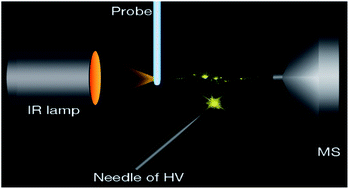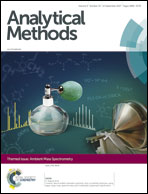Infrared atmospheric solids analysis probe (IR-ASAP) mass spectrometry for ambient analysis of volatile compounds without heated gas†
Abstract
Atmospheric solids analysis probe (ASAP) mass spectrometry is an effective means for rapidly analyzing liquids, solids, or material surfaces by direct introduction into an atmospheric pressure (AP) ionization source. A sample is typically placed on the exterior of a disposable melting point tube and the hot gas from a heated electrospray ionization probe or an AP chemical ionization probe is used to vaporize the sample prior to ionization. While the method is operationally simple and effective, the requirement of a heated gas increases the complexity and expense of the ionization method, especially for applications requiring portability. Here we demonstrate a simple instrument independent source design which uses an infrared lamp (IR) to achieve sample evaporation prior to gas-phase discharge ionization. By miniaturizing the ionization chamber and vaporizing the sample in close proximity to the entrance aperture of the mass spectrometer, mass spectra are generated similar to the ASAP method, but without need for gas flow. The IR lamp can be switched on only when sample is present for more energy efficiency. Using similar amounts of sample, some compounds are more readily observed using the new approach while with others, dimer formation and oxidation are more prevalent.

- This article is part of the themed collection: Ambient Mass Spectrometry


 Please wait while we load your content...
Please wait while we load your content...